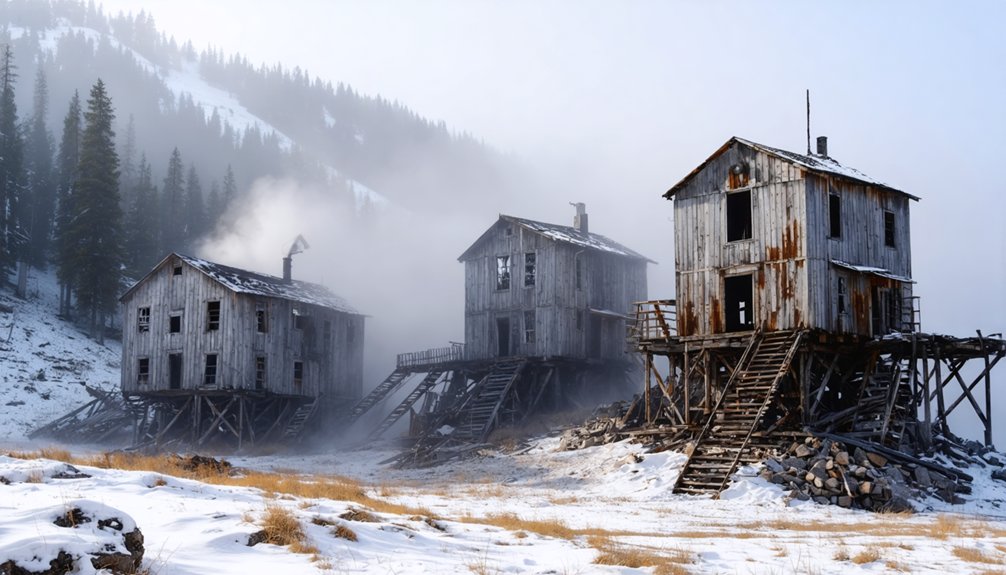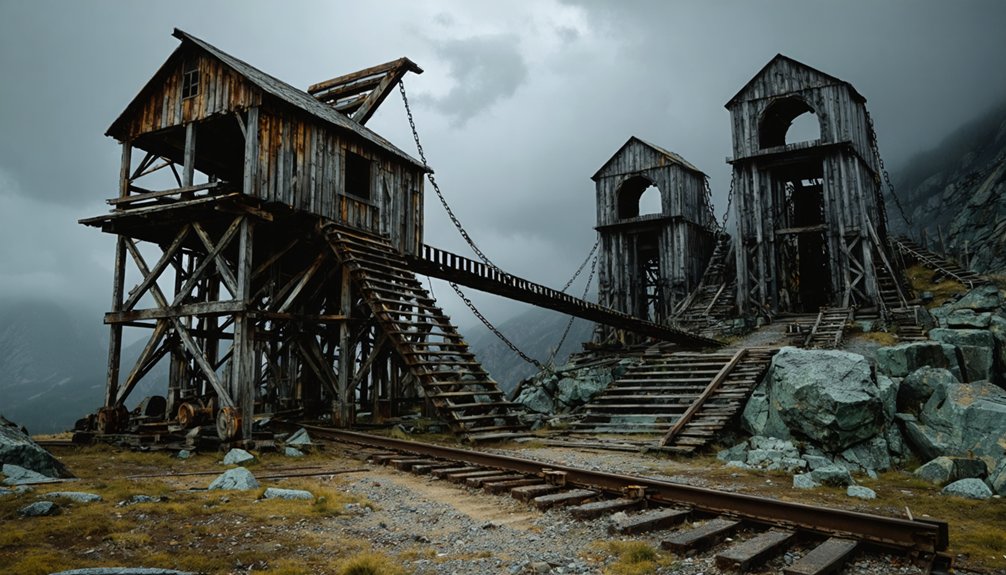Colorado’s most impressive mining ghost towns include Ashcroft, which boomed to 2,000 residents before declining when silver deposits proved shallow; Tomboy Mine, perched at 11,500 feet with its unique “Social Tunnel” and Rothschild investment; and Animas Forks, an exceptionally preserved high-altitude settlement at 11,200 feet. You’ll find compelling stories of boom-and-bust cycles, harsh living conditions, and surprising amenities like YMCAs and bowling alleys. These haunting ruins reveal much more about Colorado’s rich mining heritage.
Key Takeaways
- Ashcroft offers nine preserved buildings with rich silver mining history and cultural significance dating back to the 1880s.
- Tomboy Mine sits at 11,500 feet with haunting ruins that showcase the resilience of miners who lived in extreme conditions.
- Animas Forks features exceptional preservation at 11,200 feet, including the historic Duncan house built in 1879.
- All three ghost towns are listed on the National Register of Historic Places for their historical importance.
- These mining camps provide glimpses into Colorado’s mining boom era through their unique infrastructure and community stories.
Ashcroft: The Silver Boom Town That Vanished Almost Overnight
When spring arrived in the Castle Creek Valley in 1880, prospectors Charles B. Culver and W.F. Coxhead discovered silver, triggering Colorado’s next mining boom.
Initially dubbed “Castle Forks City,” the settlement was renamed Ashcroft in 1882 after a major ore strike yielded an astonishing 14,000 ounces per ton.
You’ll find Ashcroft’s story remarkable for its meteoric rise and fall. Within three years, over 2,000 residents populated this boomtown, establishing 20 saloons, 6 hotels, and 2 newspapers.
By 1883, it even outpaced neighboring Aspen.
The dream collapsed quickly when deposits proved shallow. A rich strike in Aspen and the Denver & Rio Grande Railroad bypassing Ashcroft sealed its fate. The mining community formed a Miners Protective Association with 97 members to develop the town before its decline.
By 1885, only 100 seasonal residents remained.
Today, you can explore nine preserved buildings, witnessing firsthand the ephemeral nature of silver discovery. The ghost town was officially listed on the National Register of Historic Places in 1975 to protect its cultural significance.
Tomboy Mine: Colorado’s Alpine Gold Mining Legacy
Perched at a breathtaking 11,500 feet above sea level, Tomboy Mine stands as one of Colorado’s most dramatically situated alpine mining operations.
You’ll find this once-thriving community in Savage Basin, roughly 3,000 feet above Telluride. During its 47-year history from 1880 to 1927, Tomboy yielded millions in gold, silver, and other metals, eventually catching the Rothschilds’ attention who purchased it for $2 million in 1897.
Nestled in Savage Basin, Tomboy’s mineral riches attracted even the Rothschilds during its nearly five-decade run.
Despite harsh conditions, miners built impressive mining infrastructure including a school, store, and YMCA. Up to 2,000 people once called this challenging environment home. The town was unique for its “Social Tunnel” where miners would meet single women from Telluride, as women were prohibited from living in Tomboy.
Though relatively peaceful compared to nearby operations, Tomboy wasn’t without violence, including the 1919 execution of four miners.
Today, you can explore the haunting ruins via Jeep or mountain bike—tangible remnants of Colorado’s rich mining heritage. The community enjoyed recreational activities like bowling tournaments between Tomboy and Smuggler mine workers.
Animas Forks: A High-Altitude Ghost Town Preserved in Time
Located at a staggering 11,200 feet in the rugged San Juan Mountains, Animas Forks stands as one of Colorado’s most remarkably preserved high-altitude ghost towns. Founded in 1873 near three rivers’ confluence, this once-thriving mining community reached 450 residents by the late 1870s, complete with hotels, stores, and its own newspaper. The well-preserved Duncan house built in 1879 remains as the largest home in the town.
You’ll walk among structures that survived since the silver boom days, now protected on the National Register of Historic Places. The town’s mining heritage remains visible in remaining cabins and infrastructure that withstood alpine conditions long after the 1893 silver crash triggered its decline. A devastating fire in 1891 destroyed 14 buildings, though the town was rebuilt despite never fully recovering.
Accessible via the Alpine Loop Scenic Byway, this BLM-managed site offers you an authentic glimpse into Colorado’s frontier past through exceptional historic preservation efforts.
Frequently Asked Questions
How Accessible Are These Ghost Towns During Winter Months?
Most ghost towns have limited winter accessibility due to snow-packed roads. You’ll need 4WD vehicles, chains, or snowshoes. Lower-elevation sites remain accessible, while high-elevation camps become virtually impassable.
Are There Guided Tours Available at These Mining Camps?
Grab your smartphone—you’ll find abundant guided tour options at Colorado’s mining camps, highlighting their historical significance. Professional interpreters lead underground explorations, jeep excursions, and candlelit museum visits throughout these freedom-filled frontier relics.
Can Visitors Take Artifacts From These Abandoned Sites?
No, you shouldn’t take artifacts. It’s illegal on federal and protected lands, with serious legal implications including fines. Artifact preservation guarantees these historical treasures remain intact for future generations to appreciate.
What Wildlife Might Be Encountered When Exploring These Areas?
You’ll encounter diverse wildlife sightings from elk and black bears to chipmunks and over 250 bird species. Look for animal tracks near water sources and in meadows surrounding these high-elevation mining ruins.
How Dangerous Are the Remaining Mine Shafts Today?
Like tombstones hiding in wilderness, abandoned mine shafts pose deadly threats. You’re risking your life with every step—unstable ground, toxic gases, thousand-foot drops, and collapsing structures compromise mine safety and shaft stability.
References
- https://www.denver7.com/news/local-news/colorado-ghost-towns-their-past-present-and-future-in-the-rocky-mountains
- https://www.youtube.com/watch?v=P53JM1SOKyw
- https://www.legendsofamerica.com/co-ghosttowns/
- https://www.youtube.com/watch?v=I4bDY6e76NU
- https://gunnisoncrestedbutte.com/blog/hike-to-colorados-abandoned-mining-camps/
- https://www.youtube.com/watch?v=hj3nMz2fKbE
- https://www.sandradallas.com/colorado-ghost-towns-and-mining
- https://archives.colorado.gov/collections/historic-mine-reports
- https://www.uchealth.org/today/ghost-towns-abound-in-colorado/
- https://www.coloradolifemagazine.com/blog/post/11-colorado-ghost-towns



